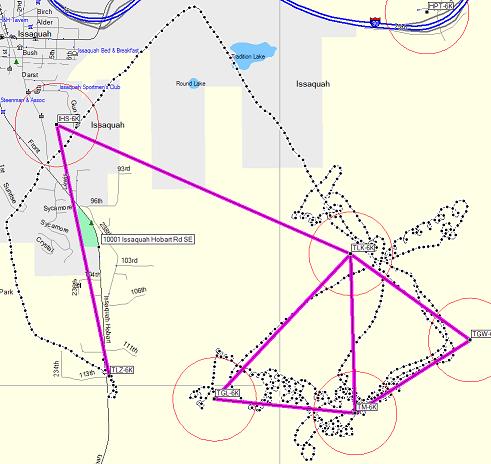Tiger Tag Rules
Objective
The objective of the competition is to tag as many waypoints as efficiently as possible. A tag is considered successful when you log a GPS track point within a .25mi radius of the waypoint. This is how turnpoints are scored in competitions.
Valid Flight
In order for a flight to be considered for scoring, it must meet the following criteria:
- Launch from one of the two official Tiger mountain launches. Both North and South launch are inside the "TGL-6K" .25mi radius. There must be a GPS trackpoint inside this start cylinder to get a successful start. The TGL-6K waypoint cannot be used as a tag unless another waypoint is tagged first.
- Include at least one tag other than launch if landing in the Tiger LZ, or no other tags if landing out from the Tiger LZ. Note: the LZ (TLZ-6K) is not a Tiger Tag waypoint, it is just the LZ marker.
- Not violate the Terminal Controlled Airspace (TCA) in our area (see Waypoints)
- Not fly in clouds.
- GPS track submitted by the end of the 7th day beginning on the day after the flight.
Scoring
Flight score = Base score * ( 100% + Time factor ) * ( 100% + Wing factor )
Base score = Distance score + ( Unique waypoints x 3 ) + LZ bonus
Distance score: The distance score for a flight is equal to the total ground miles measured from the centers of tagged waypoints from Tiger launch waypoint to landing. If no waypoints are tagged, the score is equal to the distance in miles from Tiger launch to the landing. If there are no waypoints tagged and the landing is at the Tiger LZ, the flight is not valid and will not be scored.
If landing out, the furthest trackpoint from the last waypoint tagged, or launch, is used to measure the best distance. This allows the pilot to use their altitude to fly over an unlandable area to get the best distance and fly back to a landing area without being penalized for choosing a safe landing point.
- Laps between waypoints: A waypoint can be tagged many times durng the flight. In order for the repeated waypoint to be included in the final route, there must be two other waypoints tagged before coming back to a previously tagged waypoint.
Unique Waypoints Tagged: Each unique waypoint tagged in the flight will receive 3 points.
LZ Bonus: To separate laps from further out and back flights, the LZ bonus is equal to the furthest tagged waypoint from the LZ and is only awarded if the pilot lands in either of two places:
- Tiger LZ. Land within a .1 mi radius cylinder around the normal Tiger LZ.
- Top land. Land back on a Tiger launch.
Time Factor: The time factor is calculated as a percentage of the base score and is a reward for flying fast around a long route.
- Time starts with the first track log outside the launch waypoint. This is just like a start cylinder centered on launch that you see in major competitions.
- Time stops with the time stamp of the first entry into the LZ cylinder without tagging any other waypoints after that, or the landing time if landing out.
- The time factor is calculated as a percentage of the base score: Time factor = ( Base score / time ) / 2 as a percentage
Wing Factor: The final score is multiplied by a factor to even out the advantages of higher perfomance wings.
- 25% : Tandem
- 20% : DHV 1 or 1-2
- 10% : DHV 2 or DHV 2-3
- 0% : DHV 3 or unrated
Example

The flight started at 5:30:20pm and stopped at 6:59:40pm.
The route, after dropping repeated waypoints that did not have two different waypoints between them was TGL->TM->TGW->TLK->TGL->TM->TGW->TLK->TM->TGW->TLK->IHS->TLZ
The first TGL is not counted as a tag because it is the lauch cylinder waypoint. The last TLZ is not counted because it is the LZ cylinder waypoint and is not a tag. The unique waypoints are TM TGW TLK TGL IHS so the unique waypoints bonus is 5 x 3 = 15
The route distance was 12.41mi
The flight ended in the LZ, so the LZ bonus is the most distant waypoint, which is IHS at 1.89mi
The base score is 12.41 + 15 + 1.89 = 29.30
The task time is 6:50:40 - 5:30:20 = 1:20:20 which is 80 minutes (rounded down to the nearest minute)
The time factor is ( 29.30 / 80 ) / 2 = 0.183125 (or 18.3125%)
The flight was made on a DHV2/3 wing and gets a 10% wing factor
The final score is 29.30 x ( 1 + 0.183125 ) x ( 1 + 0.10 ) = 38.13
Note: the program that calculates the score based on the tracklog keeps the highest accuracy possible without rounding until the final score, which is then rounded to 2 decimal places. The program calculates exact distances between waypoints. If you perform your own scoring, there may be minor differences in the final score. The program's score is the one used by the competition scorers.
Competition
There are two classes in the competition : weekday flights and weekend flights.
For the monthly results, the best three flights for the month will be used.
For the season competition, the best six flights will be used.
Class
There are 2 classes in the competition : Serial for wings rated DHV 1-2 and below, Open for everyone else. The highest rate wing flown for the month / season decides the class.
